Gardening often presents the challenge of protecting plants from pests while ensuring environmental safety. Many are wary of chemical pesticides due to their potential adverse effects. So, how can we ensure both adequate protection and safety without using chemical pesticides? Well, thankfully, there are plenty of options when it comes to natural pesticides. Also, as a plus, many of these natural pesticides can easily be made with common household ingredients!
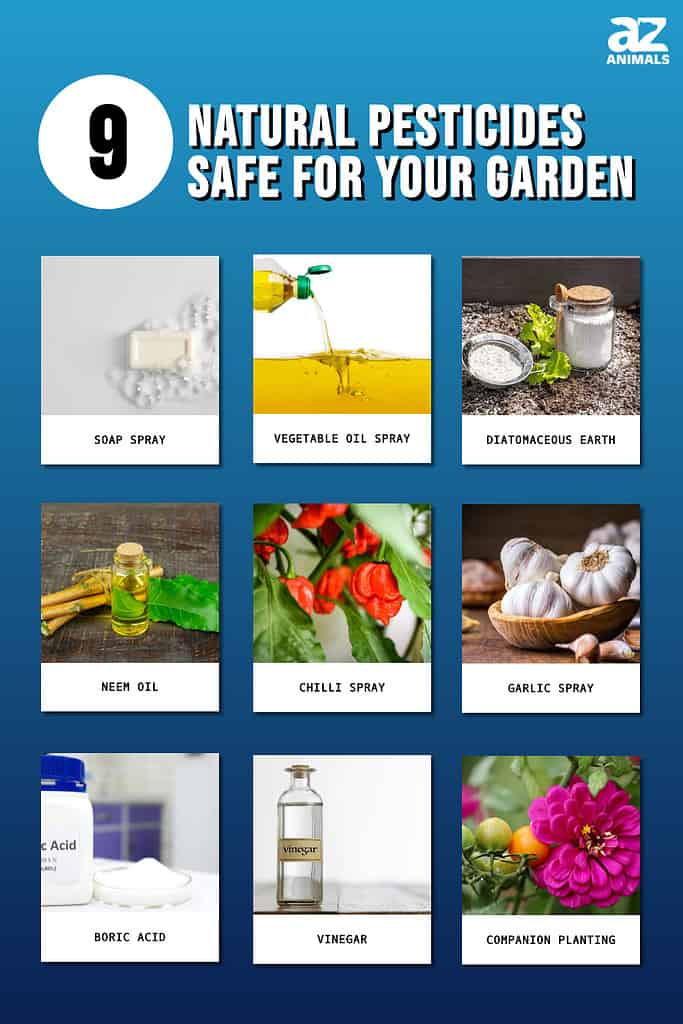
This article will explore natural and eco-friendly pesticides that help maintain a healthy, pest-free garden to make the most of your plants and the environment!
1. Soap Spray
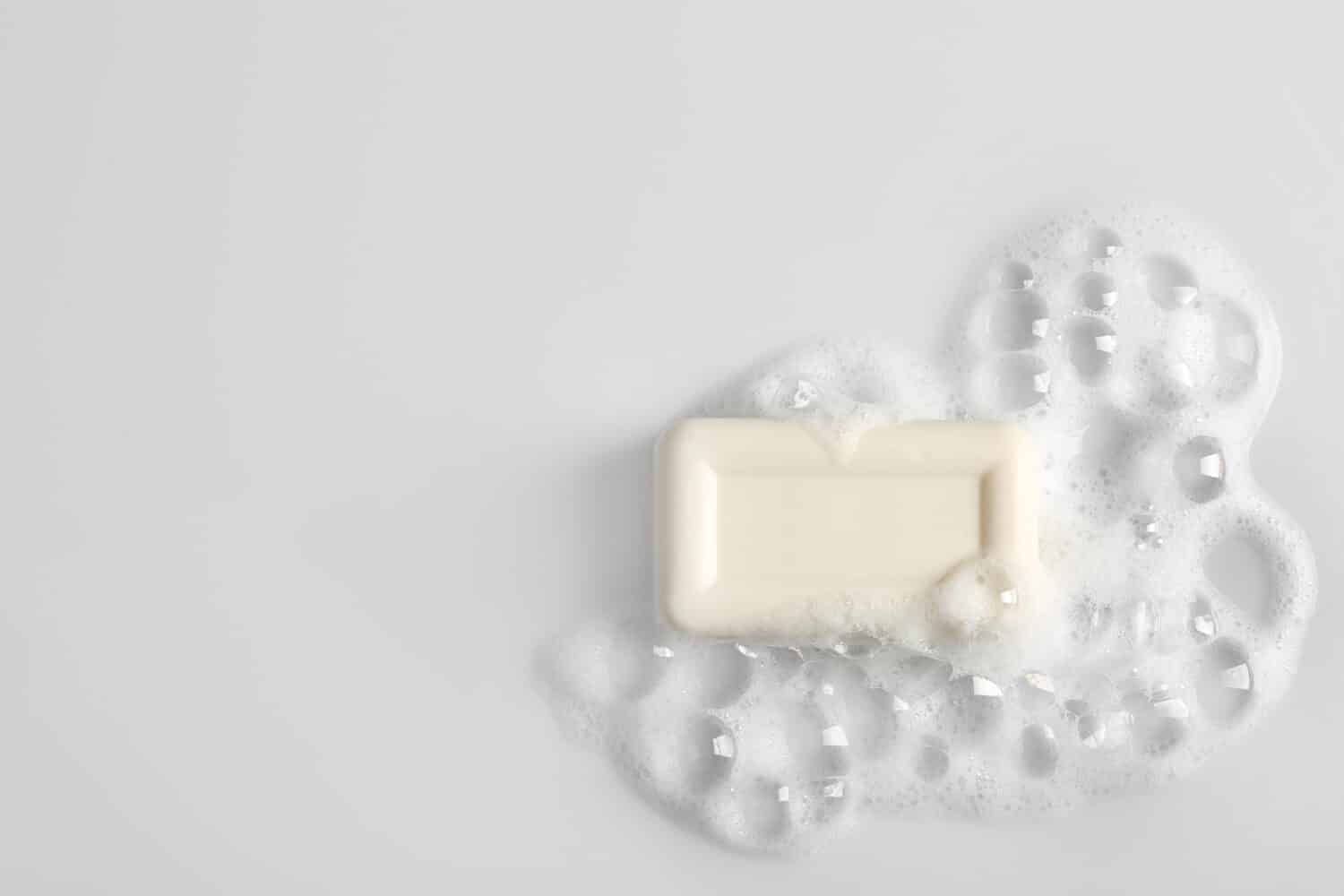
Yes, soap! Soap is efficient against aphids, mites, and whiteflies.
©New Africa/Shutterstock.com
Soap spray is one of the most straightforward and eco-friendly solutions for combating various garden pests. At its core, the method requires only dish soap and water. Yet, it is super efficient against soft-bodied insects like aphids, mites, and whiteflies. When applied directly, the soap solution disrupts the outer membranes of these pests, ultimately causing their demise. Moreover, since soap sprays lack harsh chemicals commonly found in commercial pesticides, they present a more environmentally friendly alternative. They are also generally safe for plants, beneficial insects, and the gardener. However, just to be on the safe side, absolutely avoid spraying beneficial insects directly with the soap spray!
To make your soap spray pesticide, simply take a standard spray bottle and fill it with water. Make sure to leave a little space at the top. Add a teaspoon of liquid dish soap or another soap to the bottle. Then shake well to ensure the soap mixes uniformly with the water. Note that it’s essential to use soap free from harsh chemicals or detergents to ensure plant safety. Once prepared, spray the solution directly onto the plants, mainly targeting areas with prevalent pests. For the best results, apply during calmer parts of the day, like early morning or late afternoon, to minimize the risk of potential plant stress. Constantly monitor your plants for any adverse reactions and rinse them with clear water if any signs of damage appear.
2. Vegetable Oil Spray

Another common natural pesticide ingredient is vegetable oil, which you can mix with soap and water to create a vegetable oil spray.
©Naypong Studio/Shutterstock.com
Vegetable oil spray is another method favored among gardeners looking for a practical yet natural method to tackle bothersome pests. Its potency lies in its ability to smother and suffocate soft-bodied insects, such as aphids, mites, and whiteflies. When combined with soap, the solution emulsifies, improving its spread and cling on plant surfaces and thus enhancing its insecticidal properties.
Mix one cup of vegetable oil with a tablespoon of mild, chemical-free soap in a bottle to prepare a vegetable oil spray pesticide. This mixture serves as your concentrated solution. When ready to apply, mix two tablespoons of this concentrate with a quart of water in a spray bottle. Shake well to mix it all together! Spray directly onto the affected plants. Ensure you cover both the top and underside of leaves, as pests often reside in these sheltered areas. As with any remedy, I recommend testing the spray on a small portion of the plant first and monitoring for any adverse reactions. As always, it’s also best to apply the spray during the morning or afternoon to minimize any potential plant stress.
3. Diatomaceous Earth

Diatomaceous earth is a super efficient natural pesticide that causes physical damage to insects thanks to their sharp edges.
©FotoHelin/Shutterstock.com
Made from the fossilized remains of diatoms, this pale, powdery substance works mechanically rather than chemically, making it a favored choice among environmentally conscious gardeners. The microscopic sharp edges of DE particles inflict physical damage to insects. It pierces their exoskeletons and causes them to dehydrate and die. Since it acts physically, pests cannot develop resistance to it, unlike many chemical alternatives. Moreover, it poses minimal threats to beneficial insects, pets, and humans. Just make sure to use food-grade diatomaceous earth and avoid inhaling the powder directly.
To use diatomaceous earth as a pesticide in your garden, ensure you purchase food-grade DE, which is safe for plants and animals. Wearing a mask to avoid inhalation, lightly sprinkle or dust the powder onto affected plants, focusing on the tops and undersides of leaves, stems, and soil around the base. Make sure to do this when it’s dry outside, as DE may lose its effectiveness when wet. Due to this reason, you may need to reply for continued protection after rainfall or watering. Finally, while DE is generally safe, keep it away from flowering plants to ensure that pollinators, like bees, aren’t adversely affected when visiting the blooms. While DE is generally safe for non-target insects, it’s best to take precautions to protect beneficial insects.
4. Neem Oil
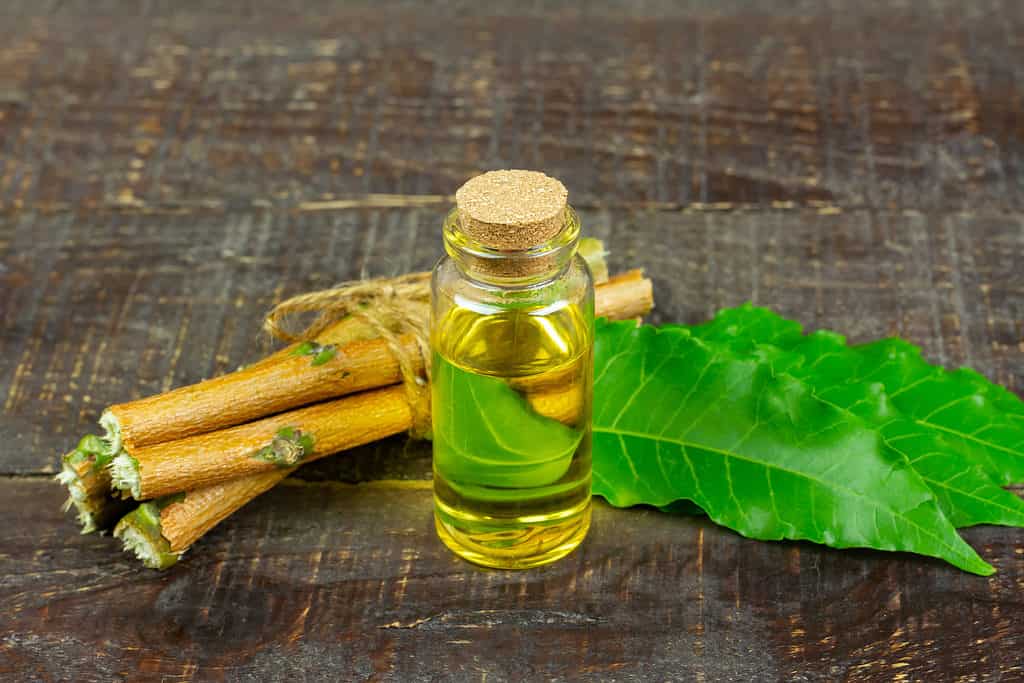
Another common natural pesticide you can use to get rid of pests in your garden is neem oil.
©iStock.com/Ninetechno
Neem oil, derived from the seeds of the neem tree, is another powerful natural pesticide that has gained widespread acclaim for its efficacy against a myriad of garden pests. Rich in azadirachtin, a compound that disrupts pests’ life cycle, neem oil is a deterrent for insects at various stages, from larvae to adults. It repels pests, interferes with their feeding, and hampers their hormonal systems, preventing reproduction and maturation. Besides its action against pests, neem oil also boasts antifungal properties, protecting against various fungal diseases afflicting plants.
To harness the benefits of neem oil in your garden, start by creating a spray. Mix two teaspoons of pure, cold-pressed neem oil with a few drops of mild, chemical-free soap and a quart of warm water in a spray bottle. The soap acts as an emulsifying agent, allowing the oil to blend with water. After shaking well, spray the solution generously on all parts of the affected plants. Pay particular attention to the undersides of leaves where pests often reside. It’s best to apply the neem oil spray during the early morning or late evening to avoid the peak sun hours, as the oil can act synergistically with the sun and potentially burn the plants. Regular applications, typically once a week or after heavy rainfall, will ensure continued protection against pests and diseases.
5. Chili Spray

The capsaicin present in chilis makes chili spray an efficient pesticide against harmful insects and creatures.
©iStock.com/_jure
Chili spray is an age-old natural remedy, tapping into peppers’ spicy compounds to ward off various garden pests. The critical component of chilies, capsaicin, is a deterrent against insects and even some more significant problems, making it a valuable tool in organic gardening. While its pungency repels and deters pests from feeding, it poses little to no harm to plants or beneficial insects when used correctly. Besides its pesticidal attributes, the spiciness of the chili also acts as a strong repellent for mammals. It deters creatures like rabbits and squirrels from nibbling on your tasty plants.
To craft your chili spray pesticide, you’ll need a couple of hot peppers (the hotter, the better), a couple of cups of water, and a drop or two of mild soap. Begin by blending the chilies with water until you have a fine mixture. Strain this liquid to remove solid particles, then add it to a spray bottle with the soap, which helps the solution adhere to plant surfaces. Shake well and, wearing gloves and eye protection (to avoid any accidental contact with the spicy concoction), spray the mixture onto the affected plants, ensuring thorough coverage. It’s essential to coat both the top and bottom of leaves. Reapply every few days or after rainfall for consistent protection. Remember to wash your hands thoroughly after use. Also, always test the spray on a small portion of the plant first to ensure no adverse reactions occur.
6. Garlic Spray
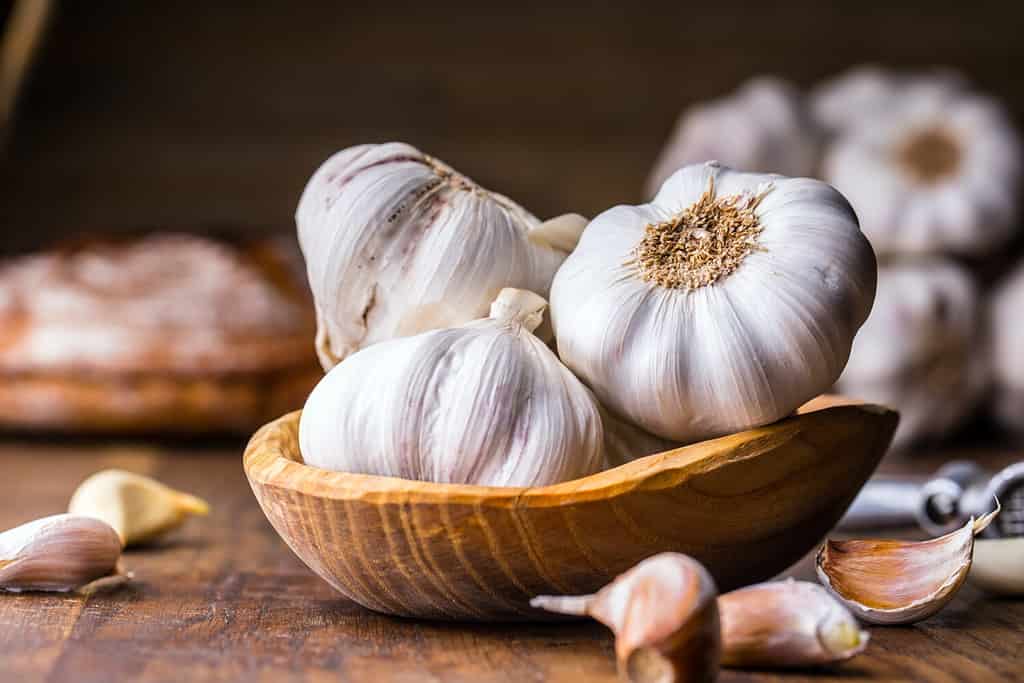
To use garlic spray as a natural pesticide, take a couple of bulbs of garlic, blend it with water, strain it, and mix it with a couple of drops of soap.
©Marian Weyo/Shutterstock.com
When transformed into a spray, garlic becomes a potent natural pesticide, deterring various pests, from aphids to whiteflies. The sulfur compounds inherent in garlic repel insects and serve as an antifungal agent. This makes garlic spray a dual-purpose solution for pests and certain plant diseases. Unlike many commercial pesticides, garlic spray is eco-friendly, ensuring minimal disturbance to beneficial insects, the soil ecosystem, and the surrounding environment. The strong scent masks the usual odors that attract pests to plants, making it harder for them to locate their next meal.
Creating a garlic spray is a straightforward process. Begin by taking 2 to 3 entire bulbs of garlic and blending them with a couple of cups of water. Allow this mixture to sit overnight, which helps intensify the protective compounds. The following day, strain the liquid to discard any solid particles. Then, mix it with a few drops of mild, chemical-free soap in some water. The soap is a sticking agent, ensuring the garlic solution adheres to plant surfaces easily. Transfer this mixture to a spray bottle. Before applying broadly, always test the garlic spray on a small section of the plant and observe for any reactions over a day. If all seems well, spray on the entire plant, including the undersides of leaves. Reapply the spray once a week and after significant rainfall.
7. Boric Acid
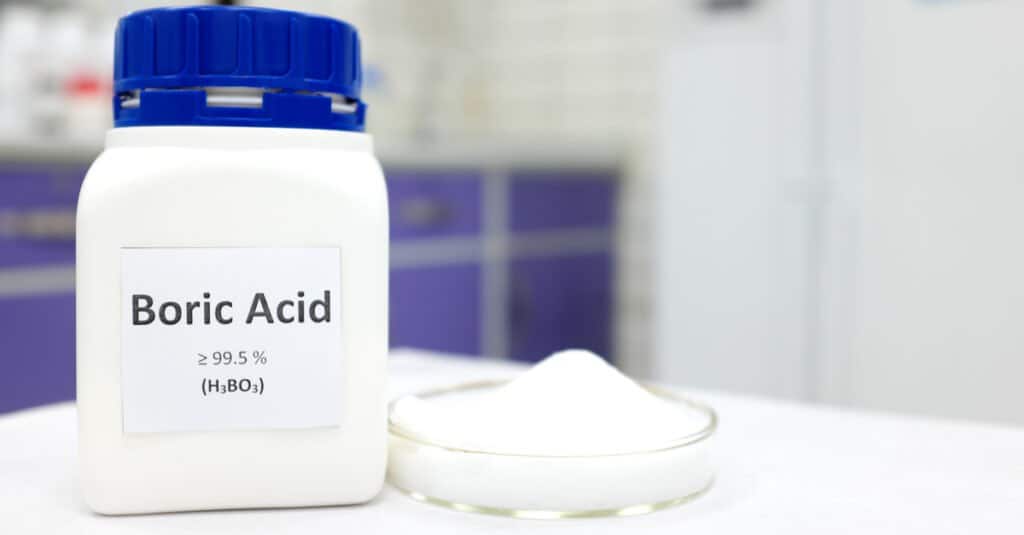
While boric acid can be a useful pesticide, make sure to use gloves and avoid inhaling it.
©sulit.photos/Shutterstock.com
Boric acid, a naturally occurring mineral derived from boron, has long been recognized for its pesticidal qualities, particularly against common pests like ants, cockroaches, and silverfish. But how does it work? Once the boric acid is ingested by pests, it disrupts their digestive systems and alters their metabolism and nervous system, which eventually kills them. One of the standout features of boric acid as a pesticide is its relatively low toxicity to humans and pets compared to many commercial chemical insecticides. However, while it’s less toxic, care should still be taken when using and storing boric acid to ensure it doesn’t come into contact with food or areas frequented by pets and children.
A common garden and household use approach involves creating bait stations to target specific pests. For instance, to manage an ant infestation, mix boric acid with sugar and water to make a bait paste. The sugar attracts the ants, while the boric acid is the lethal agent. Place this mixture in affected areas, ensuring it’s out of reach of non-target animals. Always use boric acid sparingly, as excessive amounts can deter pests from the bait rather than attracting them. Furthermore, when applying boric acid, use gloves and avoid inhalation or contact with the eyes. Regularly monitor bait stations and replace them as needed until the infestation subsides.
8. Vinegar

It’s no surprise that vinegar can act as a natural pesticide due to its acidic nature.
©focal point/Shutterstock.com
Vinegar, a versatile household staple, offers potential benefits as a natural bug deterrent due to its strong acidic nature. Its pungent aroma and taste can act as a repellent, making it unwelcome to various pests that might otherwise find their way into gardens and homes. Acetic acid, the primary component of vinegar, creates an environment that’s inhospitable for many tiny pests. Vinegar can be especially effective against common nuisances like ants, fruit flies, and other soft-bodied insects when used as a repellent. Furthermore, vinegar presents fewer environmental concerns as a natural substance than many other types of pesticides, reducing potential harm to beneficial animals and the surrounding ecosystem.
You can easily make a vinegar pesticide by mixing equal parts of water and white vinegar in a spray bottle. If you want, you can add a couple of drops of dish soap for added potency, which helps the solution adhere to surfaces. Before broadly spraying your plants, make sure to test on a small portion first, as some plants may be sensitive to acidity.
For pests like ants, spray the solution along their trails and entry points to disrupt their pheromone paths and deter future invaders. When dealing with fruit flies, make a trap by filling a bowl with apple cider vinegar, adding a few drops of dish soap to break the surface tension, and covering it with plastic wrap pierced with small holes. The scent will lure them in, and they’ll get trapped inside. While vinegar can be an effective repellent and a deterrent, it’s important to remember that it might not exterminate all pests, and you may need to reapply regularly.
9. Companion Planting

Plant certain plants together, such as zinnia and tomatoes (pictured) to take advantage of companion planting, which can help deter pests.
©Molly Shannon/Shutterstock.com
Companion planting is an agricultural practice that can surprisingly work as a natural and sustainable pest control method. The principle is rooted in biodiversity; planting certain plants in proximity to one another can deter pests or act as a trap crop, drawing pests away from more valuable crops. For instance, when planted near broccoli or cabbage, nasturtiums attract aphids, shielding the main crops from infestation. Similarly, marigolds have a scent that repels soil nematodes and other pests, making them valuable companions for many vegetables. Of course, the actual efficiency of companion planting as a pesticide depends on what types of plants you plant and the pests you want to control.
When planting companion plants, the proximity for planting these plants can vary. But as a general rule, they should be close enough to the main crop to mask its scent or serve as an immediate alternative for pests. This can range from a few inches to a couple of feet, depending on the size and nature of the plants involved. The beauty of this approach is that it not only aids in pest management but also promotes a balanced ecosystem within the garden, often enhancing pollination and improving soil health as well!
Summary of Natural Pesticides Safe For Your Garden
| Number | Natural Pesticide |
|---|---|
| 1 | Soap Spray |
| 2 | Vegetable Oil Spray |
| 3 | Diatomaceous Earth |
| 4 | Neem Oil |
| 5 | Chilli Spray |
| 6 | Garlic Spray |
| 7 | Boric Acid |
| 8 | Vinegar |
| 9 | Companion Planting |
Thank you for reading! Have some feedback for us? Contact the AZ Animals editorial team.







